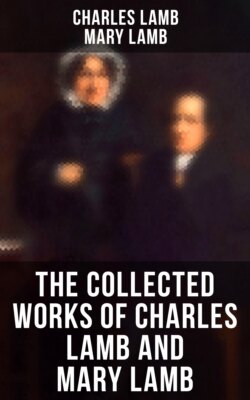Читать книгу The Collected Works of Charles Lamb and Mary Lamb - Charles Lamb - Страница 72
На сайте Литреса книга снята с продажи.
I.—REYNOLDS AND LEONARDO DA VINCI
ОглавлениеTable of Contents
(1813)
The Reynolds Gallery has upon the whole disappointed me. Some of the portraits are interesting. They are faces of characters whom we (middle-aged gentlemen) were born a little too late to remember, but about whom we have heard our fathers tell stories, till we almost fancy to have seen them. There is a charm in the portrait of a Rodney, or a Keppel, which even a picture of Nelson must want for me. I should turn away after a slight inspection from the best likeness that could be made of Mrs. Anne Clark; but Kitty Fisher is a considerable personage. Then the dresses of some of the women so exactly remind us of modes which we can just recall; of the forms under which the venerable relationships of aunt or mother first presented themselves to our young eyes; the aprons, the coifs, the lappets, the hoods. Mercy on us, what a load of head-ornaments seem to have conspired to bury a pretty face in the picture of Mrs. Long, yet could not! Beauty must have some "charmed life" to have been able to surmount the conspiracy of fashion in those days to destroy it. The portraits which least pleased me were those of boys as infant Bacchuses, Jupiters, &c. But the Artist is not to be blamed for the disguise. No doubt the parents wished to see their children deified in their life-time. It was but putting a thunderbolt (instead of a squib) into young master's hands, and a whey-faced chit was transformed into the infant Ruler of Olympus, him who was afterwards to shake heaven and earth with his black brow. Another good boy pleased his grandmama with saying his prayers so well, and the blameless dotage of the good old woman imagined in him an adequate representative of the infancy of the awful prophet Samuel. But the great historical compositions, where the Artist was at liberty to paint from his own idea—the Beaufort and the Ugolino;—why then, I must confess, pleading the liberty of Table-Talk for my presumption, that they have not left any very elevating impressions upon my mind. Pardon a ludicrous comparison. I know, Madam, you admire them both; but placed opposite to each other as they are at the Gallery, as if to set the one work in competition with the other, they did remind me of the famous contention for the prize of deformity, mentioned in the 173d number of the Spectator. The one stares and the other grins; but is their common dignity in their countenances? Does any thing of the history of their life gone by peep through the ruins of the mind in the face, like the unconquerable grandeur that surmounts the distortions of the Laocoon?—The figures which stand by the bed of Beaufort are indeed happy representations of the plain unmannered old Nobility of the English Historical Plays of Shakspeare; but for any thing else—give me leave to recommend these Macaroons.
After leaving the Reynolds Gallery, where, upon the whole, I received a good deal of pleasure, not feeling that I had quite had my fill of paintings, I stumbled upon a picture in Piccadilly (No. 22, I think), which purports to be a portrait of Francis the First by Leonardo da Vinci. Heavens, what a difference! It is but a portrait as most of those I had been seeing; but placed by them it would kill them, swallow them up as Moses's rod the other rods. Where did those old painters get their models? I see no such figures, not in my dreams, as this Francis, in the character, or rather with the attributes of John the Baptist. A more than mortal majesty in the brow and upon the eyelid—an arm muscular, beautifully formed—the long graceful massy fingers compressing, yet so as not to hurt, a lamb more lovely, more sweetly shrinking, than we can conceive that milk-white one which followed Una. The picture altogether looking as if it were eternal—combining the truth of flesh with a promise of permanence like marble.
Leonardo, from the one or two specimens we have of him in England, must have been a stupendous genius. I scarce can think he has had his full fame—he who could paint that wonderful personification of the Logos or third person of the Trinity, grasping a globe, late in the possession of Mr. Troward of Pall-Mall, where the hand was by the boldest licence twice as big as the truth of drawing warranted, yet the effect to every one that saw it, by some magic of genius, was confessed to be not monstrous, but miraculous and silencing. It could not be gainsaid.
